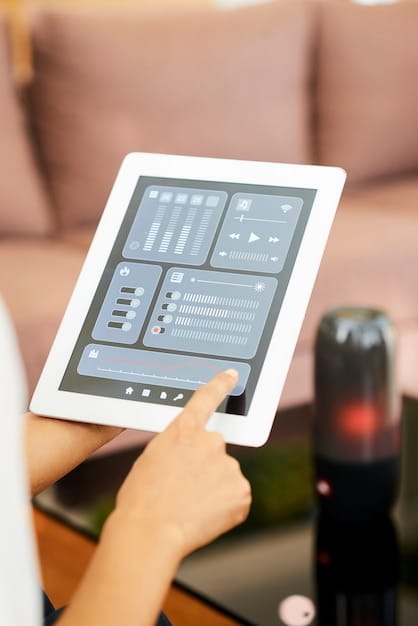The Future of Tablets: Exploring 2025 Innovations & Features

The Future of Tablets: Exploring the Latest Features and Innovations in 2025 envisions enhanced processing power, flexible displays, advanced AI integration, improved battery life, and seamless connectivity, transforming how we interact with technology for work, entertainment, and education.
What will tablets look like in 2025? Join us as we explore the future of tablets: exploring the latest features and innovations in 2025, predicting the groundbreaking changes set to revolutionize these portable devices.
The Evolving Landscape of Tablet Technology
The tablet market is constantly evolving. To understand where tablets are headed in 2025, it’s crucial to look at the current trends and technological advancements pushing the boundaries of what’s possible.
Current Tablet Trends
Several trends are currently shaping the tablet market, influencing the direction of future innovations. These include:
- Increased focus on productivity features like detachable keyboards and stylus support.
- Growing demand for larger screens and improved display technologies such as OLED and mini-LED.
- Integration of 5G connectivity for faster and more reliable internet access on the go.
- Advancements in processor technology for smoother multitasking and enhanced gaming experiences.
These trends reflect a shift in how tablets are being used, moving beyond simple entertainment devices to powerful tools for work and creativity.
Technological Advancements Driving Innovation
Several key technological advancements are paving the way for exciting new tablet features and capabilities:
- Flexible display technology, potentially leading to foldable or rollable tablets.
- AI and machine learning integration for smarter and more personalized user experiences.
- Advancements in battery technology for longer battery lives and faster charging.
- Improved camera systems with enhanced computational photography capabilities.
These advancements promise to make tablets more versatile, powerful, and user-friendly.
The tablet market is poised for significant transformation. The convergence of current trends and technological advancements will define the future of tablets, offering consumers devices that are more capable and adaptable than ever before.

Enhanced Processing Power and Performance
A key aspect of the future of tablets is the anticipated boost in processing power and overall performance. Faster processors and optimized software will enable tablets to handle more demanding tasks with ease.
Next-Generation Processors
Tablets in 2025 are expected to feature next-generation processors offering significant performance improvements. This includes:
- Faster CPU and GPU speeds for smoother multitasking and gaming.
- Improved power efficiency for longer battery life.
- Enhanced AI processing capabilities for smarter features and applications.
- Integration of advanced security features directly into the processor.
These advancements will make tablets more responsive and capable, rivaling the performance of laptops and desktops in many tasks.
Optimized Software and Operating Systems
Software optimization will play a crucial role in maximizing the performance of future tablets. This includes:
- Operating systems designed to take full advantage of advanced processor capabilities.
- Improved memory management for smoother multitasking and reduced lag.
- Enhanced support for demanding applications such as video editing and 3D modeling.
Optimized software will ensure that tablets can deliver a seamless and responsive user experience, regardless of the task at hand.
Enhanced processing power and optimized software will redefine what’s possible with tablets, empowering users to tackle demanding tasks with ease and efficiency. These advancements will solidify the position of tablets as versatile tools for both work and entertainment.
Revolutionary Display Technologies
Display technology is central to the tablet experience. In 2025, we anticipate significant advancements in tablet displays, including the adoption of flexible screens and improved image quality.
Flexible and Foldable Screens
One of the most exciting potential developments in tablet technology is the introduction of flexible and foldable screens. This could lead to:
- Tablets that can fold into smaller, more portable sizes.
- Devices with larger screens that can be unfolded for enhanced productivity and media consumption.
- More durable and impact-resistant displays.
Flexible displays would revolutionize tablet design, offering users greater versatility and convenience.
Improved Image Quality and Resolution
Beyond flexible screens, tablets in 2025 are likely to feature significant improvements in display quality, including:
- Higher resolutions for sharper and more detailed images.
- Improved color accuracy and wider color gamuts for more vibrant and realistic visuals.
- Higher refresh rates for smoother motion and reduced blur.
These advancements will enhance the visual experience, making tablets ideal for watching movies, playing games, and creating digital art.
Revolutionary display technologies will transform the tablet experience, offering users devices that are not only more versatile and durable but also capable of delivering stunning visuals. The evolution of display technology will be a key factor in shaping the future of tablets.
AI and Machine Learning Integration
Artificial intelligence (AI) and machine learning (ML) are set to play a significant role in the future of tablets, enabling smarter and more personalized user experiences.
Personalized User Experiences
AI and ML can be used to create more personalized tablet experiences, including:
- Adaptive interfaces that adjust to individual user preferences.
- Intelligent recommendations for apps, content, and services.
- Predictive features that anticipate user needs and provide proactive assistance.
These features will make tablets more intuitive and user-friendly, adapting to the unique needs and preferences of each user.
Enhanced Productivity and Creativity Tools
AI and ML can also enhance productivity and creativity tools on tablets, offering features such as:
- AI-powered voice assistants for hands-free control and information retrieval.
- Intelligent stylus support with handwriting recognition and gesture control.
- AI-driven photo and video editing tools for professional-quality results.
By leveraging the power of AI and ML, tablets can become powerful tools for content creation and productivity.
The integration of AI and machine learning will transform tablets into smarter, more personalized devices that can adapt to the unique needs of each user. These advancements will enhance both the user experience and the capabilities of tablets as tools for work and creativity.

Improved Battery Life and Charging Technologies
Battery life is a critical factor for tablet users. In 2025, we expect advancements in battery technology and charging solutions that will significantly improve the user experience.
Next-Generation Battery Technologies
Battery technology is constantly evolving, and future tablets are likely to benefit from these advancements, including:
- Higher energy density batteries that can store more power in a smaller space.
- Improved battery management systems that optimize power consumption.
- New battery chemistries that offer longer lifespans and faster charging times.
These advancements will enable tablets to last longer on a single charge, reducing the need for frequent recharging.
Faster and More Efficient Charging
In addition to improved battery technology, tablets in 2025 are likely to feature faster and more efficient charging solutions, such as:
- Wireless charging capabilities for convenient and cable-free charging.
- Fast charging technologies that can rapidly replenish battery power.
- Power-saving modes that extend battery life when needed.
Faster and more efficient charging will ensure that tablets are always ready when you need them.
Improved battery life and charging technologies will address a key pain point for tablet users, offering devices that can last longer and recharge more quickly. These advancements will enhance the overall user experience and make tablets more convenient for on-the-go use.
Seamless Connectivity and 5G Integration
Connectivity is essential for modern tablets. In 2025, we anticipate that seamless connectivity and 5G integration will become standard features, enabling faster and more reliable internet access.
5G Connectivity for Faster Speeds
5G connectivity will revolutionize the tablet experience, offering:
- Faster download and upload speeds for streaming, gaming, and content creation.
- Lower latency for more responsive online interactions.
- Improved network capacity for reliable connectivity in crowded areas.
5G connectivity will enable tablets to deliver a seamless and lag-free online experience.
Enhanced Wi-Fi Capabilities
In addition to 5G, future tablets are likely to feature enhanced Wi-Fi capabilities, including:
- Support for the latest Wi-Fi standards for faster and more reliable connections.
- Improved range and coverage for better connectivity in indoor environments.
- Advanced security features for protecting user data.
Enhanced Wi-Fi capabilities will ensure that tablets can connect seamlessly to wireless networks, wherever you are.
Seamless connectivity and 5G integration will transform tablets into powerful tools for communication, entertainment, and productivity. These advancements will enable users to stay connected and productive, regardless of their location.
| Key Feature | Brief Description |
|---|---|
| 🚀 Enhanced Processing | Faster CPUs and GPUs for smoother multitasking and gaming. |
| 📱 Flexible Displays | Foldable screens offering versatility and increased durability. |
| 🤖 AI Integration | Personalized user experiences and smart productivity tools. |
| 🔋 Battery Life | Next-gen batteries for longer use and faster charging. |
Frequently Asked Questions
▼
2025 tablets are likely to feature advanced processors with faster CPU and GPU speeds, improved power efficiency, and enhanced AI processing capabilities for smoother performance and smarter features.
▼
Flexible screens could lead to foldable tablets, offering users larger display areas in a more compact format, and enhancing the durability and impact resistance of the devices.
▼
AI will enable personalized user experiences, intelligent recommendations, and enhanced productivity tools like AI-powered voice assistants and smart stylus support, making tablets more intuitive.
▼
Future tablets will likely feature higher energy density batteries, improved battery management systems, and faster charging technologies, providing longer battery life and reducing downtime.
▼
5G connectivity will offer faster download and upload speeds, lower latency, and improved network capacity, enabling seamless streaming, gaming, and online interactions on tablets, regardless of location.
Conclusion
The future of tablets in 2025 promises to be innovative, with advancements in processing power, display technology, AI integration, battery life, and connectivity. These enhancements will transform tablets into versatile tools for work, entertainment, and education, offering users a more seamless and personalized experience.





